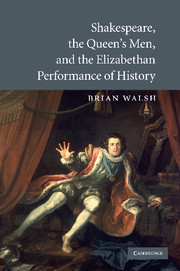Book contents
- Frontmatter
- Contents
- Acknowledgments
- Introduction
- 1 Dialogues with the dead: history, performance, and Elizabethan theater
- 2 Theatrical time and historical time: the temporality of the past in The Famous Victories of Henry V
- 3 Figuring history: Truth, Poetry, and Report in The True Tragedy of Richard III
- 4 “Unkind division”: the double absence of performing history in I Henry VI
- 5 Richard III and Theatrum Historiae
- 6 Henry V and the extra-theatrical historical imagination
- Conclusion: traces of Henry/traces of history
- Bibliography
- Index
3 - Figuring history: Truth, Poetry, and Report in The True Tragedy of Richard III
Published online by Cambridge University Press: 19 January 2010
- Frontmatter
- Contents
- Acknowledgments
- Introduction
- 1 Dialogues with the dead: history, performance, and Elizabethan theater
- 2 Theatrical time and historical time: the temporality of the past in The Famous Victories of Henry V
- 3 Figuring history: Truth, Poetry, and Report in The True Tragedy of Richard III
- 4 “Unkind division”: the double absence of performing history in I Henry VI
- 5 Richard III and Theatrum Historiae
- 6 Henry V and the extra-theatrical historical imagination
- Conclusion: traces of Henry/traces of history
- Bibliography
- Index
Summary
In his 1605 treatise The Advancement of Learning, Francis Bacon considers a major concern of Renaissance culture, the question of how those in the present seek to know and in some sense feel connected to the past:
Infinite palaces, temples, castles, cities, have been decayed and demolished […] It is not possible to have the true pictures or statues of Cyrus, Alexander, Caesar, no, nor of the kings or great personages of much later years; for the originals cannot last, and the copies cannot but leese [lose, cause the loss] of the life and truth. But the images of men's wits and knowledges remain in books, exempted from the wrong of time, and capable of perpetual renovation. Neither are they fitly to be called images, because they generate still, and cast their seeds in the minds of others, provoking and causing infinite actions and opinions in succeeding ages.
In this formulation, people like Cyrus and Alexander die, their “copies” decay, while other structures such as “temples, castles, cities” crumble and fade, thus cutting those in the present off from the physical past. Yet, Bacon sees potential for continuity as well. The past can “generate” still, working on the minds of people in the present. In an elaborate simile he goes on to write that “men's wits and knowledges,” like a ship, “pass through the vast seas of time, and make ages so distant to participate of the wisdom, illuminations, and inventions, the one of the other.”
Bacon is confident that such knowledge, presumably that which allows us to know who Cyrus and the rest are in the first place, can survive through textual inscriptions, “in books.”
- Type
- Chapter
- Information
- Publisher: Cambridge University PressPrint publication year: 2009



